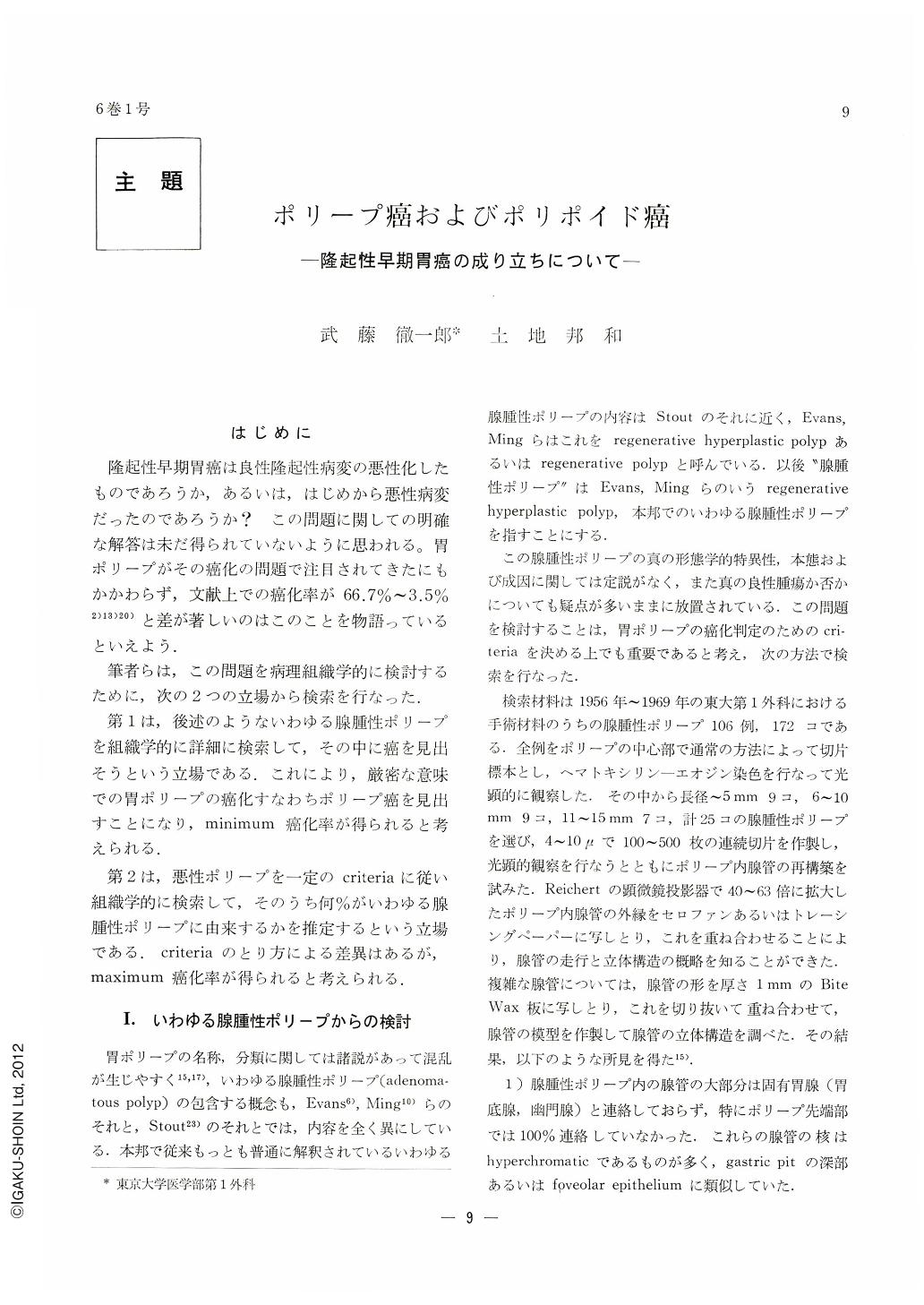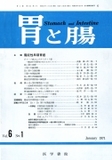Japanese
English
- 有料閲覧
- Abstract 文献概要
- 1ページ目 Look Inside
はじめに
隆起性早期胃癌は良性隆起性病変の悪性化したものであろうか,あるいは,はじめから悪性病変だったのであろうか?この問題に関しての明確な解答は未だ得られていないように思われる.胃ポリープがその癌化の問題で注目されてきたにもかかわらず,文献上での癌化率が66.7%~3.5%2)13)20)と差が著しいのはこのことを物語っているといえよう.
筆者らは,この問題を病理組織学的に検討するために,次の2つの立場から検索を行なった.
第1は,後述のようないわゆる腺腫性ポリープを組織学的に詳細に検索して,その中に癌を見出そうという立場である.これにより,厳密な意味での胃ポリープの癌化すなわちポリープ癌を見出すことになり,minimum癌化率が得られると考えられる.
第2は,悪性ポリープを一定のcriteriaに従い組織学的に検索して,そのうち何%がいわゆる腺腫性ポリープに由来するかを推定するという立場である.criteriaのとり方による差異はあるが,maximum癌化率が得られると考えられる.
Origin of malignant polypoid lesion of the stomach has been histologically investigated by focusing on the following two points: the one is to detect cancer in the so-called adenomatous polyp by detailed histological study, and the other is, histological investigation of malignant polyp according to certain criteria, to ascertain its percentage deriving from the so-called adenomatous polyp. The subjects of this study were 207 polypoid lesions in 140 cases, including 172 so-called adenomatous polyps and 35 malignant ones.
To clarify the essential structure of adenomatous polyp, the authors have investigated it by serial sectioning and reconstruction method in 25 polyps. It has been found that gastric pits within adenomatous polyp were regenerated ones having almost no connection with pyloric and fundic glands. A peculiar eosinophilic duct, “pinky duct” seen in a high rate in the adenomatous polyps probably has close relation to regeneration. Some structural atypism, as for instance. loop-like duct has been found in them, but no cellular atypism has been observed. The muscularis mucosae, passing through into the polyp with a classical appearance of a fountain, formed a core at the base. The muscularis mucosae in the adjacent parts was elevated in a tentlike fashion. Proper evaluation of the essential structure of adenomatous polyp of the stomach as compared with that of the colon and rectum shows that there is hardly resemblance between the two. Histologically considered, adenomatous polyp of the stomach should better be designated as hyperplastic polyp. Cancer has been found in three of hyperplastic polyps and focal atypicality has been seen in two, so that the rate of malignant change is presumed to he at least 1.7 per cent.
Careful observation of the behavior of the muscularis mucosae in malignant polyp shows that there are two different types in the form of the muscularis mucosae. In the one it has tent or inverted V like elevation (inverted V type), and in the other it shows box or Ω like protrusion (box or Ω type). The inverted V type muscularis mucosae constitutes one of the essential structures characteristic of hyperplasitic polyp. Presumably the inverted V type malignant polyp is preceded by hyperplastic polyp. On the other hand, the box or Ω type malignant polyp, when compared with the inverted V type one, seems to have a possibility to grow up, protruding all the while from Ⅱa to I type. In recent years, the nature of such a type has gradually been clarified by retrospective follow-up, showing that the Ω type malignant polyp was malignant from the outset.
Theoretically speaking, however, it can not be denied that among inverted V type malignant polyps transition forn Ω type is to be expected. Presumably there are 3 ways in the origination of malignant polyp. The number of inverted V type malignant polyp in the present study was 7 and that of Ω type, 27. The rate of malignant degeneration in hyperplastic polyp is thus assuemecl to be 6 per cent. When confined to polyps more than 1 cm in diameter. the rate rises up to 11 per cent; in those more than 2cm indiameter, 30 per cent.
Several problems at issue concerning the criteria for the diagnosis of malignant degeneration have also been discussecl.

Copyright © 1971, Igaku-Shoin Ltd. All rights reserved.


